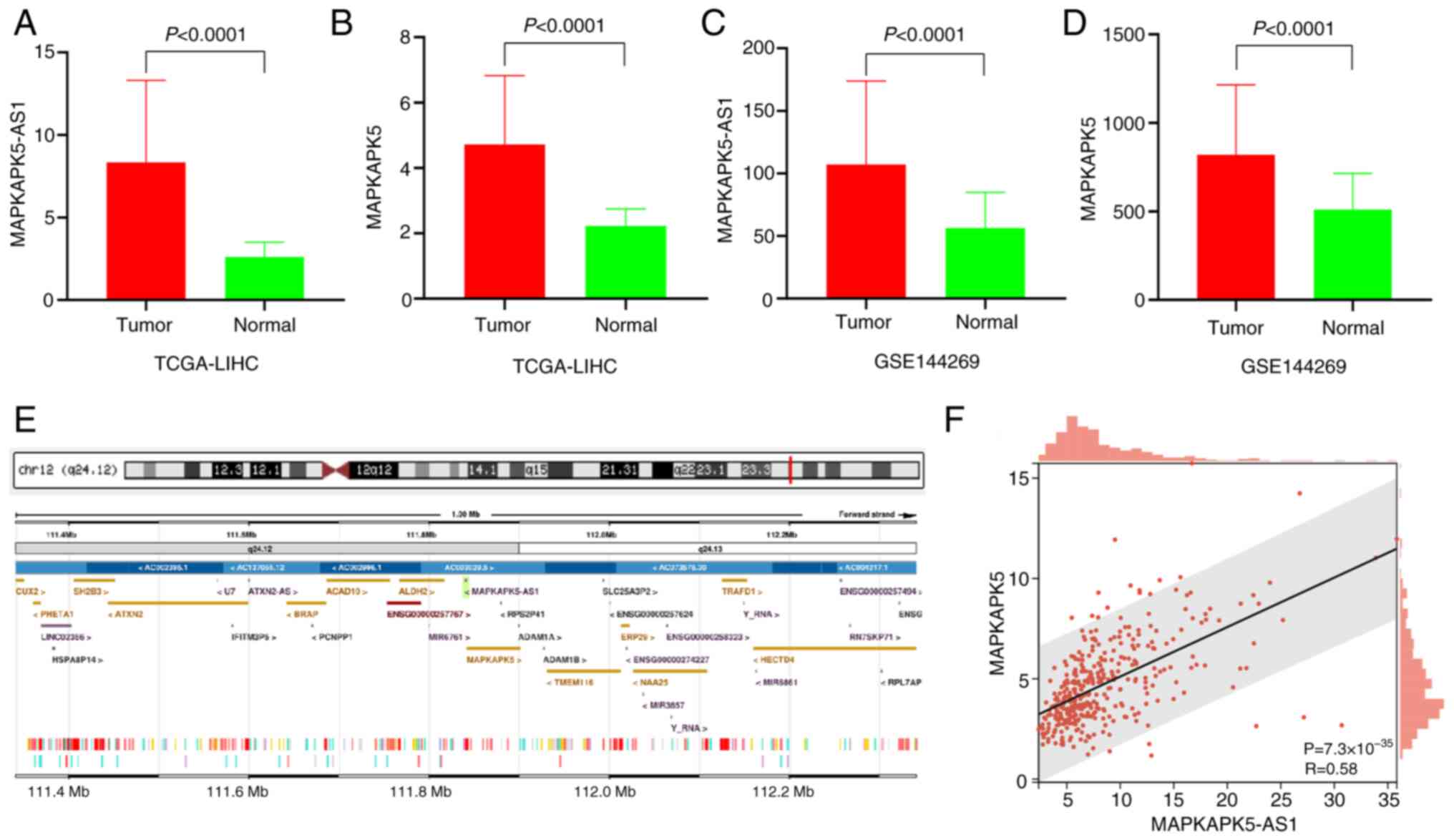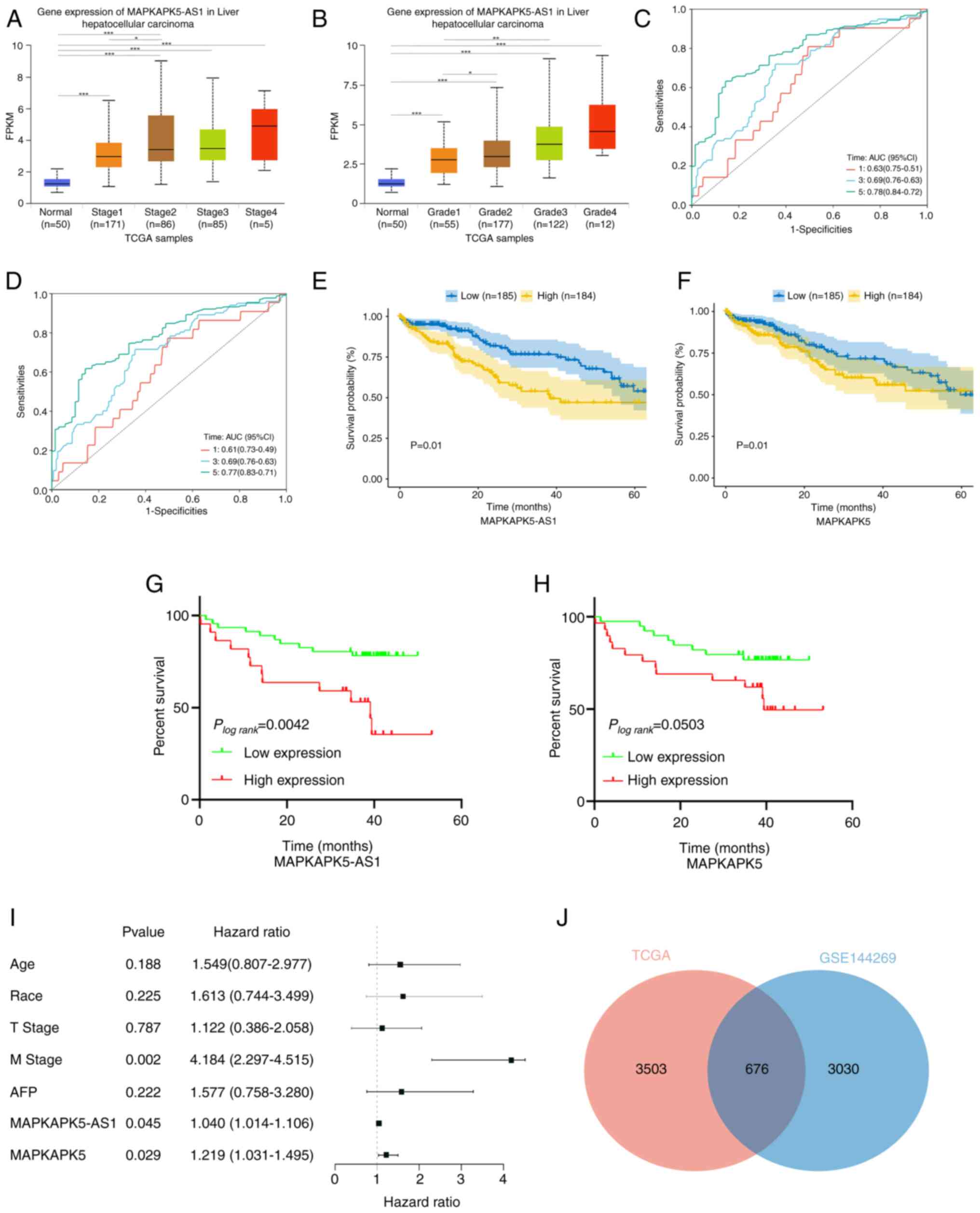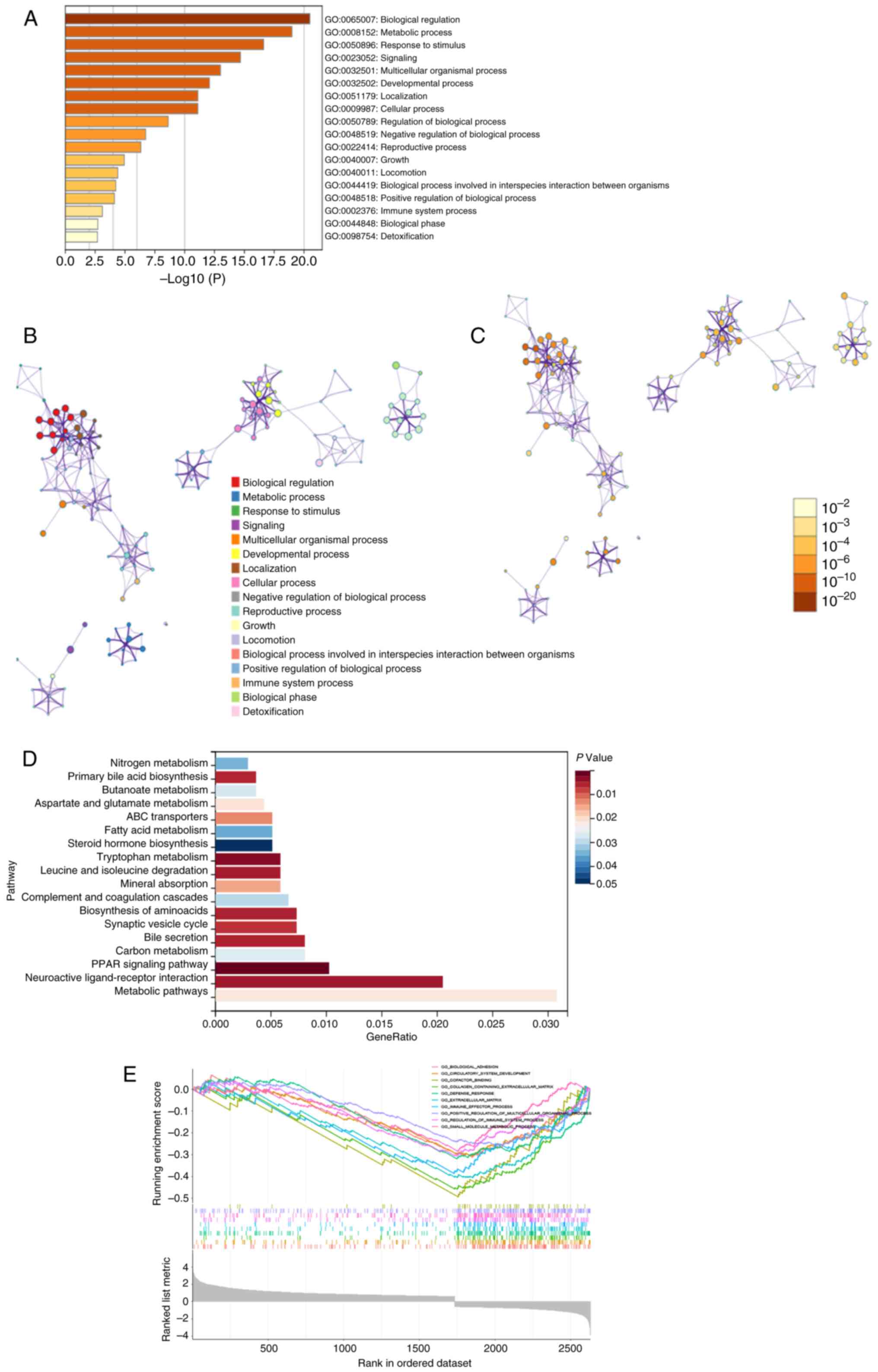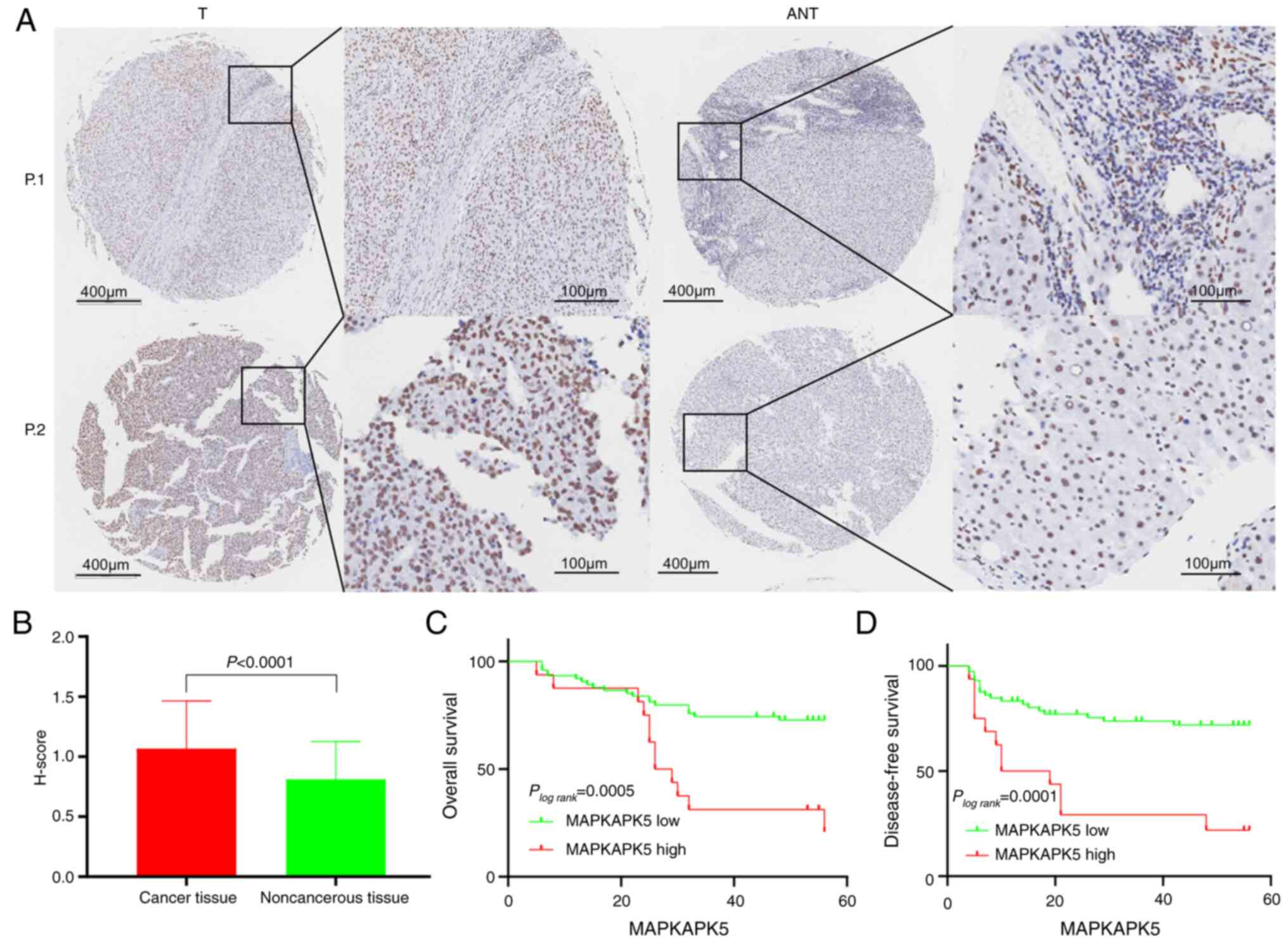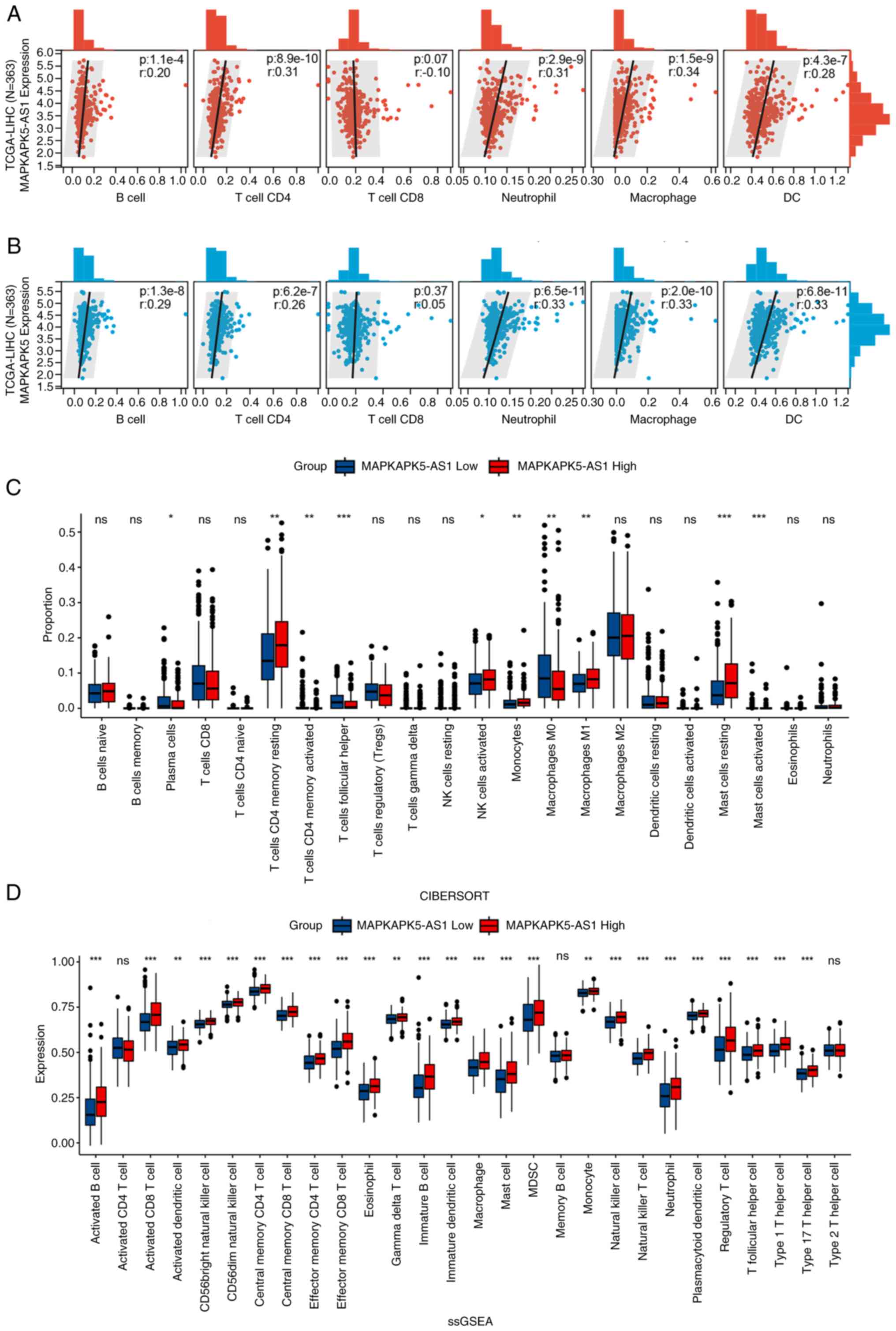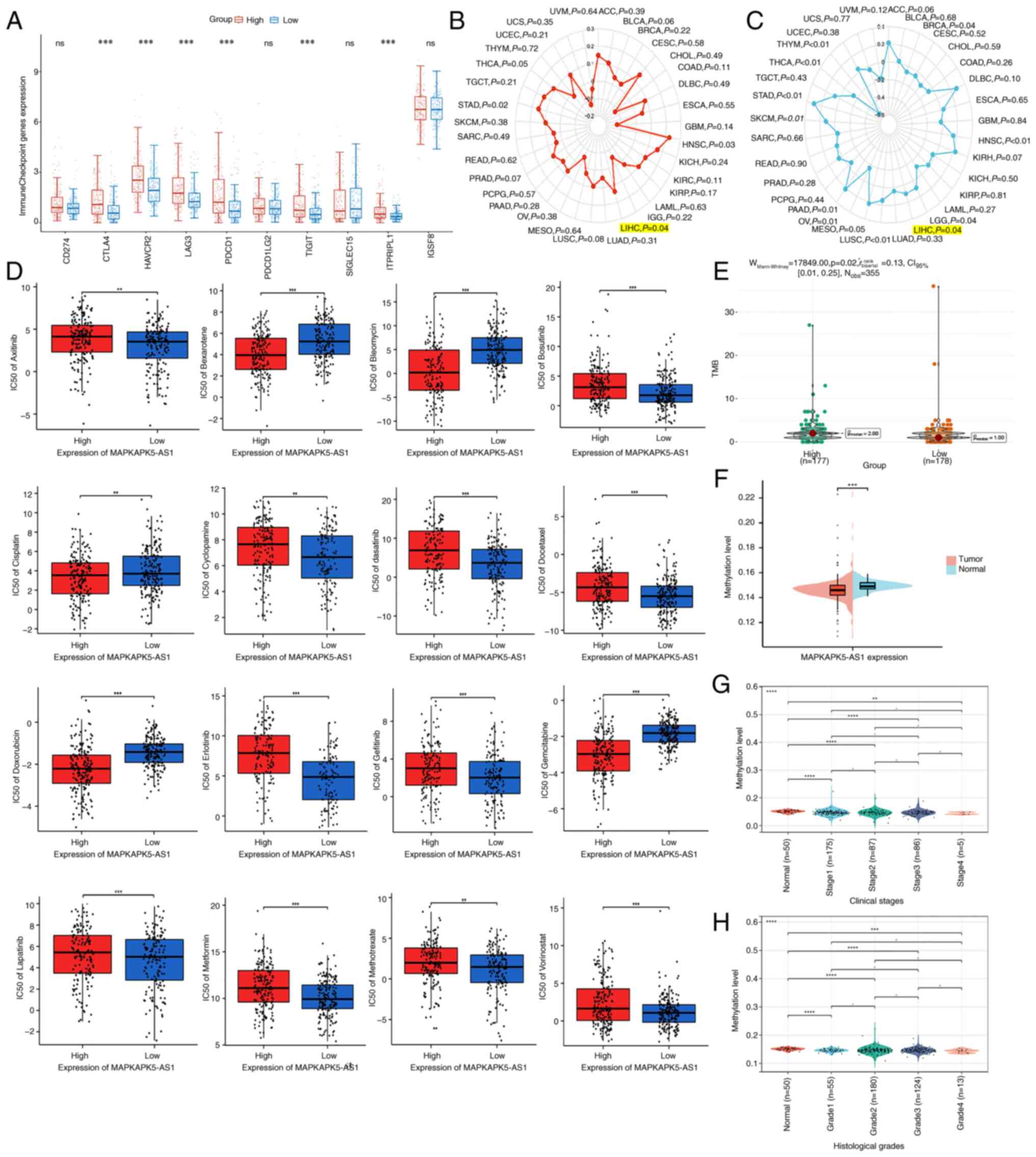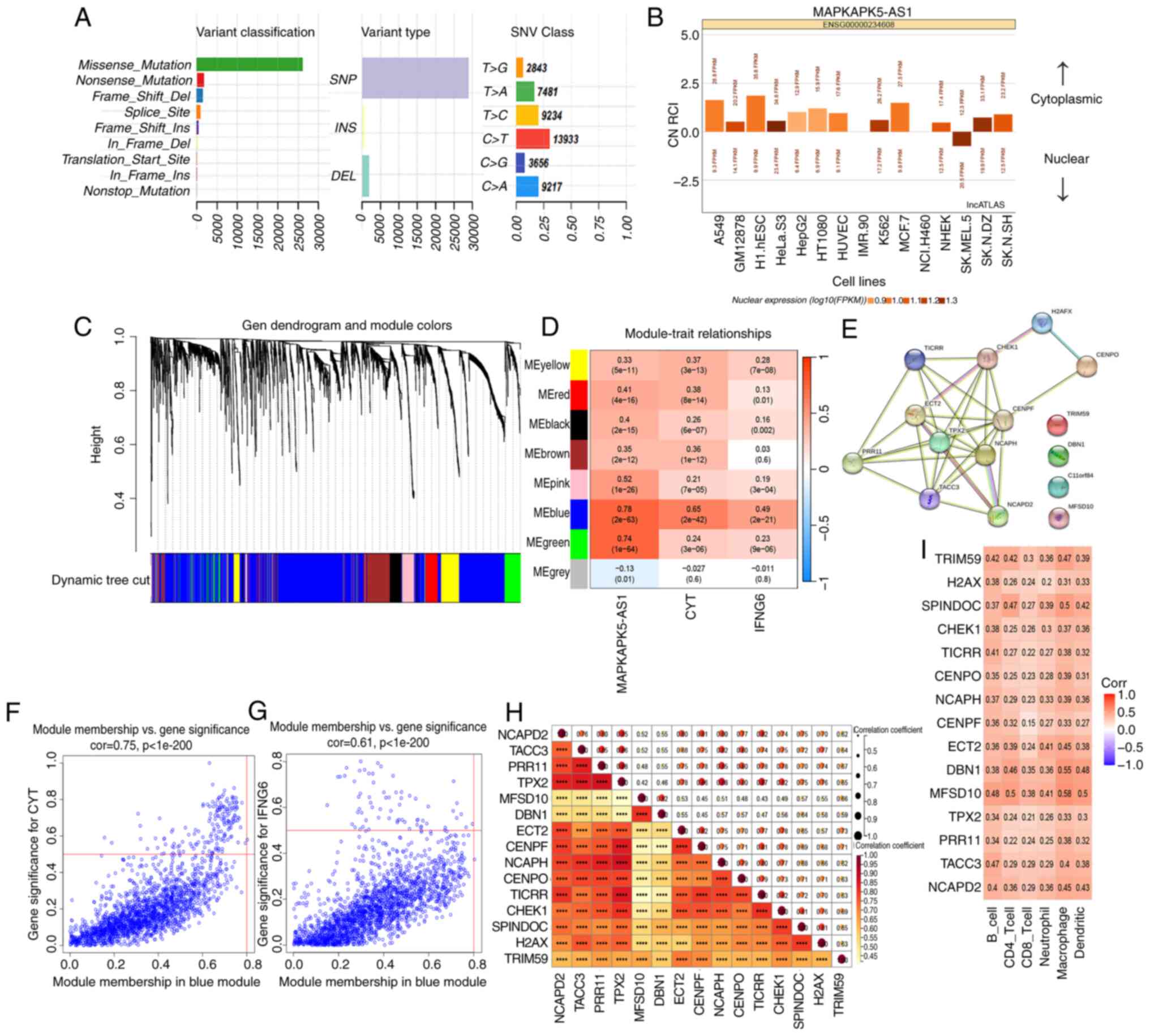|
1
|
Xie DY, Ren ZG, Zhou J, Fan J and Gao Q:
2019 Chinese clinical guidelines for the management of
hepatocellular carcinoma: Updates and insights. Hepatobiliary Surg
Nutr. 9:452–463. 2020. View Article : Google Scholar : PubMed/NCBI
|
|
2
|
Xu XF, Xing H, Han J, Li ZL, Lau WY, Zhou
YH, Gu WM, Wang H, Chen TH, Zeng YY, et al: Risk factors, patterns,
and outcomes of late recurrence after liver resection for
hepatocellular carcinoma: A multicenter study from China. JAMA
Surg. 154:209–217. 2019. View Article : Google Scholar : PubMed/NCBI
|
|
3
|
Ahn JC, Lee YT, Agopian VG, Zhu Y, You S,
Tseng HR and Yang JD: Hepatocellular carcinoma surveillance:
Current practice and future directions. Hepatoma Res.
8:102022.PubMed/NCBI
|
|
4
|
Mercer TR, Dinger ME and Mattick JS: Long
non-coding RNAs: Insights into functions. Nat Rev Genet.
10:155–159. 2009. View
Article : Google Scholar : PubMed/NCBI
|
|
5
|
Luo S, Lu JY, Liu L, Yin Y, Chen C, Han X,
Wu B, Xu R, Liu W, Yan P, et al: Divergent lncRNAs regulate gene
expression and lineage differentiation in pluripotent cells. Cell
Stem Cell. 18:637–652. 2016. View Article : Google Scholar : PubMed/NCBI
|
|
6
|
Wang H, Shi Y, Chen CH, Wen Y, Zhou Z,
Yang C, Sun J, Du G, Wu J, Mao X, et al: KLF5-induced lncRNA
IGFL2-AS1 promotes basal-like breast cancer cell growth and
survival by upregulating the expression of IGFL1. Cancer Lett.
515:49–62. 2021. View Article : Google Scholar : PubMed/NCBI
|
|
7
|
Ji H, Hui B, Wang J, Zhu Y, Tang L, Peng
P, Wang T, Wang L, Xu S, Li J and Wang K: Long noncoding RNA
MAPKAPK5-AS1s promotes colorectal cancer proliferation by partly
silencing p21 expression. Cancer Sci. 110:72–85. 2019. View Article : Google Scholar : PubMed/NCBI
|
|
8
|
Yang T, Chen WC, Shi PC, Liu MR, Jiang T,
Song H, Wang JQ, Fan RZ, Pei DS and Song J: Long noncoding RNA
MAPKAPK5-AS1 promotes colorectal cancer progression by
cis-regulating the nearby gene MK5 and acting as a let-7f-1-3p
sponge. J Exp Clin Cancer Res. 39:1392020. View Article : Google Scholar : PubMed/NCBI
|
|
9
|
Zhang H, Wang Y and Lu J: Identification
of lung-adenocarcinoma-related long non-coding RNAs by random
walking on a competing endogenous RNA network. Ann Transl Med.
7:3392019. View Article : Google Scholar : PubMed/NCBI
|
|
10
|
Gao GF, Parker JS, Reynolds SM, Silva TC,
Wang LB, Zhou W, Akbani R, Bailey M, Balu S, Berman BP, et al:
Before and after: Comparison of legacy and harmonized TCGA genomic
data commons' data. Cell Syst. 9:24–34.e10. 2019. View Article : Google Scholar : PubMed/NCBI
|
|
11
|
Barrett T, Wilhite SE, Ledoux P,
Evangelista C, Kim IF, Tomashevsky M, Marshall KA, Phillippy KH,
Sherman PM, Holko M, et al: NCBI GEO: Archive for functional
genomics data sets-update. Nucleic Acids Res. 41((Database issue)):
D991–D995. 2013.PubMed/NCBI
|
|
12
|
Zhou Y, Zhou B, Pache L, Chang M,
Khodabakhshi AH, Tanaseichuk O, Benner C and Chanda SK: Metascape
provides a biologist-oriented resource for the analysis of
systems-level datasets. Nat Commun. 10:15232019. View Article : Google Scholar : PubMed/NCBI
|
|
13
|
Newman AM, Liu CL, Green MR, Gentles AJ,
Feng W, Xu Y, Hoang CD, Diehn M and Alizadeh AA: Robust enumeration
of cell subsets from tissue expression profiles. Nat Methods.
12:453–457. 2015. View Article : Google Scholar : PubMed/NCBI
|
|
14
|
Subramanian A, Tamayo P, Mootha VK,
Mukherjee S, Ebert BL, Gillette MA, Paulovich A, Pomeroy SL, Golub
TR, Lander ES and Mesirov JP: Gene set enrichment analysis: A
knowledge-based approach for interpreting genome-wide expression
profiles. Proc Natl Acad Sci USA. 102:15545–15550. 2005. View Article : Google Scholar : PubMed/NCBI
|
|
15
|
Li H, Liu C, Huang S, Wang X, Cao M, Gu T,
Ou X, Pan S, Lin Z, Wang X, et al: Multi-omics analyses demonstrate
the modulating role of gut microbiota on the associations of
unbalanced dietary intake with gastrointestinal symptoms in
children with autism spectrum disorder. Gut Microbes.
15:22813502023. View Article : Google Scholar : PubMed/NCBI
|
|
16
|
Song J, Ren K, Zhang D, Lv X, Sun L, Deng
Y and Zhu H: A novel signature combing cuproptosis- and
ferroptosis-related genes in sepsis-induced cardiomyopathy. Front
Genet. 14:11707372023. View Article : Google Scholar : PubMed/NCBI
|
|
17
|
Rukhsan A, Supty AT, Hussain M and Lee Y:
STK3 higher expression association with clinical characteristics in
intrinsic subtypes of breast cancer invasive ductal carcinoma
patients. Breast Cancer Res Treat. 206:119–129. 2024. View Article : Google Scholar : PubMed/NCBI
|
|
18
|
Reimand J, Isserlin R, Voisin V, Kucera M,
Tannus-Lopes C, Rostamianfar A, Wadi L, Meyer M, Wong J, Xu C, et
al: Pathway enrichment analysis and visualization of omics data
using g:Profiler, GSEA, cytoscape and EnrichmentMap. Nat Protoc.
14:482–517. 2019. View Article : Google Scholar : PubMed/NCBI
|
|
19
|
Li T, Fan J, Wang B, Traugh N, Chen Q, Liu
JS, Li B and Liu XS: TIMER: A web server for comprehensive analysis
of tumor-infiltrating immune cells. Cancer Res. 77:e108–e110. 2017.
View Article : Google Scholar : PubMed/NCBI
|
|
20
|
Samstein RM, Lee CH, Shoushtari AN,
Hellmann MD, Shen R, Janjigian YY, Barron DA, Zehir A, Jordan EJ,
Omuro A, et al: Tumor mutational load predicts survival after
immunotherapy across multiple cancer types. Nat Genet. 51:202–206.
2019. View Article : Google Scholar : PubMed/NCBI
|
|
21
|
Klein O, Kee D, Markman B, Carlino MS,
Underhill C, Palmer J, Power D, Cebon J and Behren A: Evaluation of
TMB as a predictive biomarker in patients with solid cancers
treated with anti-PD-1/CTLA-4 combination immunotherapy. Cancer
Cell. 39:592–593. 2021. View Article : Google Scholar : PubMed/NCBI
|
|
22
|
Goodman AM, Kato S, Bazhenova L, Patel SP,
Frampton GM, Miller V, Stephens PJ, Daniels GA and Kurzrock R:
Tumor mutational burden as an independent predictor of response to
immunotherapy in diverse cancers. Mol Cancer Ther. 16:2598–2608.
2017. View Article : Google Scholar : PubMed/NCBI
|
|
23
|
Feng D, Hui X, Shi-Chun L, Yan-Hua B, Li
C, Xiao-Hui L and Jie-Yu Y: Initial experience of anti-PD1 therapy
with nivolumab in advanced hepatocellular carcinoma. Oncotarget.
8:96649–96655. 2017. View Article : Google Scholar : PubMed/NCBI
|
|
24
|
Geeleher P, Cox NJ and Huang RS: Clinical
drug response can be predicted using baseline gene expression
levels and in vitro drug sensitivity in cell lines. Genome Biol.
15:R472014. View Article : Google Scholar : PubMed/NCBI
|
|
25
|
Maeser D, Gruener RF and Huang RS:
oncoPredict: An R package for predicting in vivo or cancer patient
drug response and biomarkers from cell line screening data. Brief
Bioinform. 22:bbab2602021. View Article : Google Scholar : PubMed/NCBI
|
|
26
|
Xiong Y, Wei Y, Gu Y, Zhang S, Lyu J,
Zhang B, Chen C, Zhu J, Wang Y, Liu H and Zhang Y: DiseaseMeth
version 2.0: A major expansion and update of the human disease
methylation database. Nucleic Acids Res. 45((D1)): D888–D895. 2017.
View Article : Google Scholar : PubMed/NCBI
|
|
27
|
Gao J, Aksoy BA, Dogrusoz U, Dresdner G,
Gross B, Sumer SO, Sun Y, Jacobsen A, Sinha R, Larsson E, et al:
Integrative analysis of complex cancer genomics and clinical
profiles using the cBioPortal. Sci Signal. 6:pl12013. View Article : Google Scholar : PubMed/NCBI
|
|
28
|
Mas-Ponte D, Carlevaro-Fita J, Palumbo E,
Hermoso Pulido T, Guigo R and Johnson R: LncATLAS database for
subcellular localization of long noncoding RNAs. RNA. 23:1080–1087.
2017. View Article : Google Scholar : PubMed/NCBI
|
|
29
|
Li JH, Liu S, Zhou H, Qu LH and Yang JH:
starBase v2.0: Decoding miRNA-ceRNA, miRNA-ncRNA and protein-RNA
interaction networks from large-scale CLIP-Seq data. Nucleic Acids
Res. 42((Database issue)): D92–D97. 2014. View Article : Google Scholar : PubMed/NCBI
|
|
30
|
Langfelder P and Horvath S: WGCNA: An R
package for weighted correlation network analysis. BMC
Bioinformatics. 9:5592008. View Article : Google Scholar : PubMed/NCBI
|
|
31
|
Szklarczyk D, Morris JH, Cook H, Kuhn M,
Wyder S, Simonovic M, Santos A, Doncheva NT, Roth A, Bork P, et al:
The STRING database in 2017: Quality-controlled protein-protein
association networks, made broadly accessible. Nucleic Acids Res.
45:D362–D368. 2017. View Article : Google Scholar : PubMed/NCBI
|
|
32
|
Wakiyama H, Masuda T, Motomura Y, Hu Q,
Tobo T, Eguchi H, Sakamoto K, Hirakawa M, Honda H and Mimori K:
Cytolytic activity (CYT) score is a prognostic biomarker reflecting
host immune status in hepatocellular Carcinoma (HCC). Anticancer
Res. 38:6631–6638. 2018. View Article : Google Scholar : PubMed/NCBI
|
|
33
|
Seiwert TY, Burtness B, Mehra R, Weiss J,
Berger R, Eder JP, Heath K, McClanahan T, Lunceford J, Gause C, et
al: Safety and clinical activity of pembrolizumab for treatment of
recurrent or metastatic squamous cell carcinoma of the head and
neck (KEYNOTE-012): An open-label, multicentre, phase 1b trial.
Lancet Oncol. 17:956–965. 2016. View Article : Google Scholar : PubMed/NCBI
|
|
34
|
Chandrashekar DS, Karthikeyan SK, Korla
PK, Patel H, Shovon AR, Athar M, Netto GJ, Qin ZS, Kumar S, Manne
U, et al: UALCAN: An update to the integrated cancer data analysis
platform. Neoplasia. 25:18–27. 2022. View Article : Google Scholar : PubMed/NCBI
|
|
35
|
Zheng Z, Liu J, Yang Z, Wu L, Xie H, Jiang
C, Lin B, Chen T, Xing C, Liu Z, et al: MicroRNA-452 promotes
stem-like cells of hepatocellular carcinoma by inhibiting Sox7
involving Wnt/β-catenin signaling pathway. Oncotarget.
7:28000–28012. 2016. View Article : Google Scholar : PubMed/NCBI
|
|
36
|
Bertucci F, Chaffanet M and Birnbaum D: An
ICGC major achievement in breast cancer: A comprehensive catalog of
mutations and mutational signatures. Chin Clin Oncol. 6:42017.
View Article : Google Scholar : PubMed/NCBI
|
|
37
|
Li Z, Lin Y, Cheng B, Zhang Q and Cai Y:
Identification and analysis of potential key genes associated with
hepatocellular carcinoma based on integrated bioinformatics
methods. Front Genet. 12:5712312021. View Article : Google Scholar : PubMed/NCBI
|
|
38
|
Cui XY, Zhan JK and Liu YS: Roles and
functions of antisense lncRNA in vascular aging. Ageing Res Rev.
72:1014802021. View Article : Google Scholar : PubMed/NCBI
|
|
39
|
Wang J, Su Z, Lu S, Fu W, Liu Z, Jiang X
and Tai S: LncRNA HOXA-AS2 and its molecular mechanisms in human
cancer. Clin Chim Acta. 485:229–233. 2018. View Article : Google Scholar : PubMed/NCBI
|
|
40
|
Wang Y, Yang L, Chen T, Liu X, Guo Y, Zhu
Q, Tong X, Yang W, Xu Q, Huang D and Tu K: A novel lncRNA
MCM3AP-AS1 promotes the growth of hepatocellular carcinoma by
targeting miR-194-5p/FOXA1 axis. Mol Cancer. 18:282019. View Article : Google Scholar : PubMed/NCBI
|
|
41
|
Zhang JY, Weng MZ, Song FB, Xu YG, Liu Q,
Wu JY, Qin J, Jin T and Xu JM: Long noncoding RNA AFAP1-AS1
indicates a poor prognosis of hepatocellular carcinoma and promotes
cell proliferation and invasion via upregulation of the RhoA/Rac2
signaling. Int J Oncol. 48:1590–1598. 2016. View Article : Google Scholar : PubMed/NCBI
|
|
42
|
Cheng M, Zhang J, Cao PB and Zhou GQ:
Prognostic and predictive value of the hypoxia-associated long
non-coding RNA signature in hepatocellular carcinoma. Yi Chuan.
44:153–167. 2022.PubMed/NCBI
|
|
43
|
Wang W, Zhao Z, Yang F, Wang H, Wu F,
Liang T, Yan X, Li J, Lan Q, Wang J and Zhao J: An immune-related
lncRNA signature for patients with anaplastic gliomas. J
Neurooncol. 136:263–271. 2018. View Article : Google Scholar : PubMed/NCBI
|
|
44
|
Zhang J, Fan D, Jian Z, Chen GG and Lai
PB: Cancer specific long noncoding RNAs show differential
expression patterns and competing endogenous RNA potential in
hepatocellular carcinoma. PLoS One. 10:e01410422015. View Article : Google Scholar : PubMed/NCBI
|
|
45
|
Yang J, Xu QC, Wang ZY, Lu X, Pan LK, Wu J
and Wang C: Integrated analysis of an lncRNA-associated ceRNA
network reveals potential biomarkers for hepatocellular carcinoma.
J Computat Biol. 28:330–344. 2021. View Article : Google Scholar
|
|
46
|
Peng Z, Ouyang X, Wang Y and Fan Q:
MAPKAPK5-AS1 drives the progression of hepatocellular carcinoma via
regulating miR-429/ZEB1 axis. BMC Mol Cell Biol. 23:212022.
View Article : Google Scholar : PubMed/NCBI
|
|
47
|
Wedemeyer H, Hofmann WP, Lueth S, Malinski
P, Thimme R, Tacke F and Wiegand J: (ALT screening for chronic
liver diseases: Scrutinizing the evidence). Z Gastroenterol.
48:46–55. 2010.(In German). View Article : Google Scholar : PubMed/NCBI
|
|
48
|
Han P, Lei Y, Liu J, Liu J, Huang H, Tian
D and Yan W: Cell adhesion molecule BVES functions as a suppressor
of tumor cells extrusion in hepatocellular carcinoma metastasis.
Cell Commun Signal. 20:1492022. View Article : Google Scholar : PubMed/NCBI
|
|
49
|
Xu Y, Feng K, Zhao H, Di L, Wang L and
Wang R: Tumor-derived extracellular vesicles as messengers of
natural products in cancer treatment. Theranostics. 12:1683–1714.
2022. View Article : Google Scholar : PubMed/NCBI
|
|
50
|
Luu M, Riester Z, Baldrich A, Reichardt N,
Yuille S, Busetti A, Klein M, Wempe A, Leister H, Raifer H, et al:
Microbial short-chain fatty acids modulate CD8(+) T cell responses
and improve adoptive immunotherapy for cancer. Nat Commun.
12:40772021. View Article : Google Scholar : PubMed/NCBI
|
|
51
|
Ringelhan M, Pfister D, O'Connor T,
Pikarsky E and Heikenwalder M: The immunology of hepatocellular
carcinoma. Nat Immunol. 19:222–232. 2018. View Article : Google Scholar : PubMed/NCBI
|
|
52
|
Gregory SN, Perati SR and Brown ZJ:
Alteration in immune function in patients with fatty liver disease.
Hepatoma Res. 8:312022. View Article : Google Scholar
|
|
53
|
Zhang S, Liu Z, Wu D, Chen L and Xie L:
Single-Cell RNA-Seq analysis reveals microenvironmental
infiltration of plasma cells and hepatocytic prognostic markers in
HCC with Cirrhosis. Front Oncol. 10:5963182020. View Article : Google Scholar : PubMed/NCBI
|
|
54
|
Zong Z, Zou J, Mao R, Ma C, Li N, Wang J,
Wang X, Zhou H, Zhang L and Shi Y: M1 macrophages induce PD-L1
expression in hepatocellular carcinoma cells through IL-1β
signaling. Front Immunol. 10:16432019. View Article : Google Scholar : PubMed/NCBI
|
|
55
|
Yao S and Chen L: PD-1 as an immune
modulatory receptor. Cancer J. 20:262–264. 2014. View Article : Google Scholar : PubMed/NCBI
|
|
56
|
Chen X, Du Y, Hu Q and Huang Z:
Tumor-derived CD4+CD25+regulatory T cells inhibit dendritic cells
function by CTLA-4. Pathol Res Pract. 213:245–249. 2017. View Article : Google Scholar : PubMed/NCBI
|
|
57
|
Rizvi H, Sanchez-Vega F, La K, Chatila W,
Jonsson P, Halpenny D, Plodkowski A, Long N, Sauter JL, Rekhtman N,
et al: Molecular determinants of response to anti-programmed cell
death (PD)-1 and anti-programmed death-ligand 1 (PD-L1) blockade in
patients with non-small-cell lung cancer profiled with targeted
next-generation sequencing. J Clin Oncol. 36:633–641. 2018.
View Article : Google Scholar : PubMed/NCBI
|
|
58
|
Yarchoan M, Albacker LA, Hopkins AC,
Montesion M, Murugesan K, Vithayathil TT, Zaidi N, Azad NS, Laheru
DA, Frampton GM and Jaffee EM: PD-L1 expression and tumor
mutational burden are independent biomarkers in most cancers. JCI
Insight. 4:e1269082019. View Article : Google Scholar : PubMed/NCBI
|
|
59
|
Yarchoan M, Hopkins A and Jaffee EM: Tumor
mutational burden and response rate to PD-1 inhibition. N Engl J
Med. 377:2500–2501. 2017. View Article : Google Scholar : PubMed/NCBI
|
|
60
|
Jiang J, Jin Z, Zhang Y, Peng L, Zhang Y,
Zhu Z, Wang Y, Tong D, Yang Y, Wang J, et al: Robust prediction of
immune checkpoint inhibition therapy for non-small cell lung
cancer. Front Immunol. 12:6468742021. View Article : Google Scholar : PubMed/NCBI
|
|
61
|
Cai H, Zhang Y, Zhang H, Cui C, Li C and
Lu S: Prognostic role of tumor mutation burden in hepatocellular
carcinoma after radical hepatectomy. J Surg Oncol. 121:1007–1014.
2020. View Article : Google Scholar : PubMed/NCBI
|
|
62
|
Huo J, Wu L and Zang Y: A prognostic model
of 15 immune-related gene pairs associated with tumor mutation
burden for hepatocellular carcinoma. Front Mol Biosci.
7:5813542020. View Article : Google Scholar : PubMed/NCBI
|
|
63
|
Tao L, Li D, Mu S, Tian G and Yan G:
LncRNA MAPKAPK5_AS1 facilitates cell proliferation in hepatitis B
virus -related hepatocellular carcinoma. Lab Invest. 102:494–504.
2022. View Article : Google Scholar : PubMed/NCBI
|
|
64
|
Wang X, Wang J, Shen H, Luo Z and Lu X:
Downregulation of TPX2 impairs the antitumor activity of CD8+ T
cells in hepatocellular carcinoma. Cell Death Dis. 13:2232022.
View Article : Google Scholar : PubMed/NCBI
|
|
65
|
He K, Xie M, Li J, He Y and Yin Y: CENPO
is associated with immune cell infiltration and is a potential
diagnostic and prognostic marker for hepatocellular carcinoma. Int
J Gen Med. 15:7493–7510. 2022. View Article : Google Scholar : PubMed/NCBI
|
|
66
|
Si T, Huang Z, Jiang Y, Walker-Jacobs A,
Gill S, Hegarty R, Hamza M, Khorsandi SE, Jassem W, Heaton N and Ma
Y: Expression levels of three key genes CCNB1, CDΧ20, and CENPF in
HCC are associated with antitumor Immunity. Front Oncol.
11:7388412021. View Article : Google Scholar : PubMed/NCBI
|
|
67
|
Xu D, Wang Y, Wu J, Zhang Z, Chen J, Xie
M, Tang R, Chen C, Chen L, Lin S, et al: ECT2 overexpression
promotes the polarization of tumor-associated macrophages in
hepatocellular carcinoma via the ECT2/PLK1/PTEN pathway. Cell Death
Dis. 12:1622021. View Article : Google Scholar : PubMed/NCBI
|



